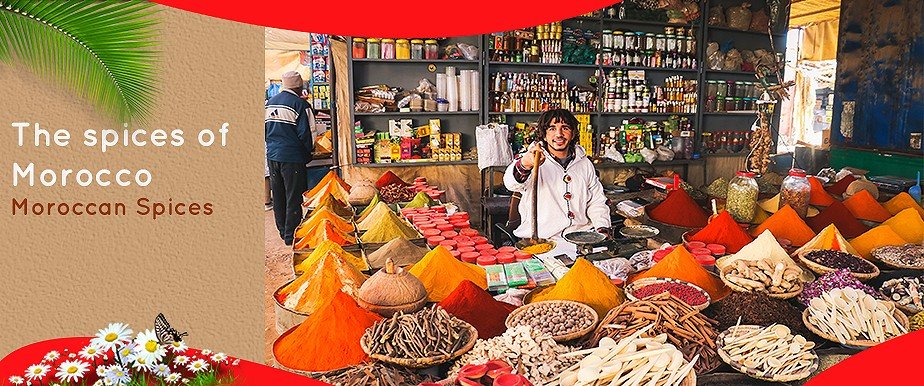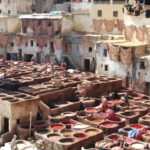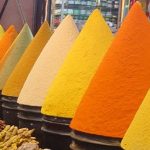Moroccan spices and their different flavors need hundreds of sentences to describe one by one. In this post, I picked a few that caught my eye during my trip to Morocco. Coming from an Asian background, initially when I hear the word spice I immediately think of heat or chilies. I think this is pretty much across the board with Asians when we think of the word ‘spice’.
Moroccan herbs and spices although have a lot of similarities or even the same spices that also originate from India. The actual way it is cooked, preserved, and used is completely different.
Table of Contents
- 1. What are the most common Moroccan spices?
- 2. Is Moroccan food spicy?
- 3. Some Moroccan foods and dishes
- 4. Breakfast
- 5. Lunch
- 6. Dinner
- 7. Desserts
- 8. Moroccan Spices
- 9. Nutmeg
- 10. Ras El Hanout
- 11. Cardamoms
- 12. Cinnamon
- 13. Paprika
- 14. Cumin
- 15. Anise seeds
- 16. Nigella seeds
- 17. Fenugreek
- 18. Conclusion: Moroccan Spices
Although Moroccan spices are used very subtly whereby the natural flavors alongside the textures are enhanced by the vegetables and fruits used.
What are the most common Moroccan spices?
Some of the most common spices are cumin, ginger, nigella seeds, saffron, mace, cloves, fennel, anise, paprika nutmeg, turmeric, cayenne pepper, fenugreek, caraway, black pepper sesame seeds. cinnamon coriander and fennel. Although there are a lot more spices, these are the ones that I thought to be the most common ones.
Is Moroccan food spicy?
It all depends on your perception, if you mean whether the food has heat and chilies, then for me, it was no way near our Asian foods. There was no heat or spiciness in the dishes whatsoever for me. Again, this is merely my opinion, and nothing is stated as facts. One thing to also bear in mind is that spice and heat all boil down to one’s own taste buds and pallets.
However, if you’re from a background where you have not experimented with any herbs or spices, and the most you utilize is just salt and pepper, then your pallet would almost be certainly bursting with the new flavors and aromas!
The colors of the spices are amazingly soft-scented dust. With its fine texture and the aroma tickling the end of your nose. The colors of the spices consist of dry sandy colors, to the vibrant ruby reds boastfully displaying the paprika and chilies.
Some Moroccan foods and dishes
When one thinks of Morocco one tends to only think of the obvious touristic foods such as the couscous or Tagines. Although yes, these dishes are a huge part of Moroccan culture but there are so many more foods to be explored.
Knowing and having someone local is a huge advantage to get to know the real ordinary foods that one consumes every day.
I know if I had a guest coming to my home, I would go out of my way to get the best fish and meats cuts. I will ensure that I cook much more than I usually do, exaggerating on the oils and masala spices I will use. However, the dish may be cooked again, but it does not really reflect on how I eat every day. This is just for guests that will be served for the temporary period. I will go back to my day-to-day routines and cook the way I normally do. In the same way, whether we visit a Moroccan Berber village or a restaurant, there is a fine line between what the tourists and local people eat on a day-to-day basis.
Breakfast
It starts with hot beverages, either creamy coffee or milky tea. Moroccans unashamedly use milk generously on their hot drinks. Some of the other drinks are, hot mint tea, or even organic freshly squeezed orange juice. Which is something that is very normal and part of Moroccan culture.
For breakfast, a savory one to have is the Loubia, which is a bean-like saucy dish that is served with flatbread. For the more common breakfasts, Morocco indulges in sweeter like carbohydrates. Some of which consist of croissants, crumpets that are served with either local honey or jam, pancakes, or ring-like doughnuts. Moroccans are not shy about having a sweet tooth and tend to have these throughout their days when they have their teas/coffees.
Lunch
Lunch is typically tagines or couscous. The not-so-common ones that most westerners don’t know about are dishes such as; zaalouk; a popular dish made from aubergines, blended with garlic, olive tomatoes, and spices. Normally served with crust bread.
For those fish lovers, there’s Fish Chermoula which is a baked fish mix with other kinds of seafood. Blended with onions, corianders chilies, and saffron. Some tend to serve with chili sauce, always a great treat for those who like a little more heat in their foods.
One to try is for sure is the stuffed camel spleen. This is a form of a sausage-like appearance stuffed with spices, lamb, beef followed with a creamy soft texture inside.
Some of the other foods are, aubergine fritters, crumbled liver (for those that hate liver or kidney texture stay away, it’s not a dish for you), Makouda- fried potato balls, steamed sheepshead, this is pretty much self-explanatory- not for the squeamish or the lighthearted! There are a whole lot more foods to explore, some of these dishes are only just touching the surface.
Dinner
Dinner normally consists of lots of various salads, followed by deep-fried samosas and kebabs. Thereafter Harira Soup, or broth-like meaty stews. Followed by pastilla chicken, or pastilla seafood. Again, most of the lunch meals can also be alternated for dinner too, similarly to the west. There is no set rule to say, a certain dish can ONLY be eaten for dinner and vice versa for lunch.
Desserts
Desserts are my favorite part of any meal! Similarly, the Moroccans pride themselves in their lavish desserts. Whether it be Ghoriba, baklawas, chebacco, Fekkas, M’hanncha, date cookies, almond cookies, and much much more. Most of the Moroccan desserts mentioned here are either a biscuit, filo, or pastry form. Although this is just a rule of thumb, other desserts are in a form of puddings or even sweet grain rice and other starches.
Moroccan Spices
Moving on to the spices and their distinguished flavors, I won’t discuss all of them because there will be hundreds to get through then. I’ve hand-picked a few that stood out to me.
Nutmeg
Nutmeg is a very subtle nutty spice, that is commonly used for desserts but can be just as well used for savory foods too. It is either used on top to garnish desserts, as a dusting powder, or roughly crushed.
Ras El Hanout
The Ras El Hanout which means ‘head to the shops’ my interpretation is, it is a spice that is the ‘all in one spice.’ The Asian alternative to that will be the ‘Mix Masala’. It has everything you need all in one spice mixed.
The Ras El Hanout is a spice that has around 20 different spices all mixed, in some parts of other places they have up to 30 or more spices and can even go up to a hundred!
I think with these spices it is more for convenience rather than a deep flavor, whilst including a minute dash of the more extravagant spices.
Although it is not an everyday spice, it is used to rub on either the fish or meats. Sometimes it is used to flavor the rice too, but ever so subtly. Since it’s a mixed spice, all the spices and aromas are entwined bursting with different scents a little is more than enough.
Cardamoms
Cardamoms are one of my least favorite spices, especially when I bite into one. Although I tend to use it, once the flavor has been absorbed I tend to pick them out. I noticed in some Moroccan dishes, cardamom seeds were generously scattered and people do eat them very casually. I find the smell and aroma too overpowering for my liking either I will have to pick it out or I will have to eat something else.
Cinnamon
Cinnamons tend to look like a bark-type stick, which is, in fact, a strong spice. It’s very good for any flu-type symptoms one may have. The cinnamon sticks are used for both savory and sweet dishes and then taken out. Since it’s a bark, it is not usual to eat the spice, but rather only used to flavor the dishes.
Paprika
Paprika is a red hot fiery colored spice, although it is not as hot as chili powder. It is mainly added to give food its luscious red royal colors.
Cumin
The cumin is part of the coriander and parsley family. It is very aromatic with a slightly bitter taste. It is believed that it does wonders for digestion in the Ayurveda methods… Cumin is used to season tagines, eggs, stews, meats, beans, and even salads.
Anise seeds
The anise seeds have a very strong distinct licorice type flavor, it is used sparingly when in baking. However, it is also used in savory cooking too where it tends to be used more generously then.
Nigella seeds
Nigellas seeds are jet black sesame-sized seeds, that are used in Moroccan cooking. Believed to heal many different illnesses. With a bitter, salty, and nutty taste, it is commonly used to garnish dishes to give off a finishing making the black seeds stand out more.
Fenugreek
Fenugreek seeds another name is Helba. Sandy golden brown color, again also very small, very similar to cumin. It’s one of those spices that are very bitter when chewed but when added creates a tantalizing aroma in the foods. It is a unique part of their foods and is added to most savory dishes. In some parts of the world, fenugreek is classified as a natural weight loss supplement, those that are wishing to shed a few extra pounds add fenugreek into the mix and see what happens!
Conclusion: Moroccan Spices
In conclusion, Moroccan foods will not be Moroccan if it does not include their amazing spices. It truly makes their food authentic and unique. It is not essential to have the same utensils or the traditional tagines clay pots. Though it may enhance the flavor and make it look more exotic, it is not essential. But one essential thing is the Moroccan spices, you will for sure need them as without them it will be a completely different dish. In the same way, a beef burger would not be a beef burger without the beef!
Join countless satisfied travelers who have experienced Morocco with us. We customize every detail to make your Moroccan adventure uniquely yours. Explore the Magic of Morocco with us!









































































































































































































































































